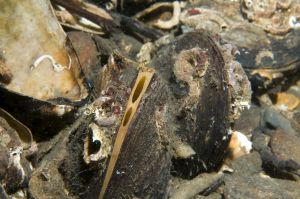Modiolus modiolus, is commonly known as horse mussel, when this species covers 30% or more of the seabed with a stabilising effect they can form what is called the Modiolus modiolus beds or reefs (OSPAR Comission, 2009; NatureScot, 2017).
Horse mussels usually live part-burried in soft to coarse sediment or attached to rocks often in tide-swept areas. The horse mussels have a wide distribution but the horse mussel beds are more limited in their distribution (OSPAR Comission, 2009).
The main threat to M.modiolus beds are fishing activities with trawls and dredges, which damage both the Modiolus and associated epibenthic species (OSPAR Comission , 2008). Aggregate extraction, trenching and pipe/cable-laying, dumping of spoil/cuttings or use of jack-up drilling rigs are also likely to damage horse mussel beds (OSPAR Comission , 2008).
Sources:
OSPAR Commission (2008). "Case Reports for the OSPAR List of Threatened and/or Declining Species and Habitats". Retrieved from https://www.ospar.org/site/assets/files/44271/horse_mussel_beds.pdf, on 2022-02-10.
OSPAR Commission (2009). "Background Document for Modiolus modiolus beds". Retrieved from https://www.ospar.org/documents?v=7193, on 2022-02-10.
NatureScot. Scotland's Nature Agency (2017). "Horse mussel beds". Retrieved from https://www.nature.scot/landscapes-and-habitats/habitat-types/coast-and-seas/marine-habitats/horse-mussel-beds on 2022-02-15.
For more information please refer to the sources cited.


 Co-funded by the European Union.
Co-funded by the European Union.